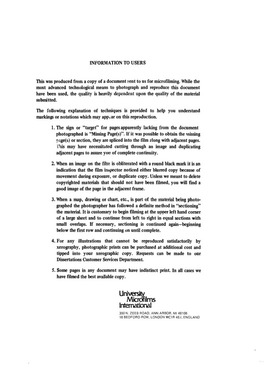| dc.contributor.author | Yang, Junyang Chen. | en_US |
| dc.date.accessioned | 2013-08-16T12:28:22Z | |
| dc.date.available | 2013-08-16T12:28:22Z | |
| dc.date.issued | 1981 | en_US |
| dc.identifier.uri | https://hdl.handle.net/11244/4875 | |
| dc.description.abstract | Three levels of development were identified to represent the environmental condition of the region under consideration. The least disturbed environments are designated as level I areas to which the strictest ecological standards is assigned to preserve and protect natural environment. The level II areas are designated by an intermediate level of human involvement in the ecological communities. Areas where large concentrations of population are located are designated as level III environments and the standards applied to these areas should be more tolerant of pollutants in the ecological systems. | en_US |
| dc.description.abstract | It is not intended that these four indicators be exhaustive; users should feel free to employ additional indicators for their study area. All the estimates of the indicator are transformed into their corresponding indicator performance level by comparing it with the maximum value in the region. They are then weighted in proportion to their relative importance. | en_US |
| dc.description.abstract | The system to establish ecological standards for water resources developments has been developed in this study. Two steps were undertaken to establish ecological standards. The first one is the categorization of development levels of natural environment by measuring specific socio-economic factors which are capable of delineating the human modification of the ecological standards in response to various development levels so as to reflect the human influence on the ecological system. | en_US |
| dc.description.abstract | Three different scales (X-axis) were proportionally developed for each of the twelve parameters reflecting the three levels of restriction. Formulas were also developed for calculating the parameter estimates. The parameter estimate obtained can be applied to the appropriate scale of a study region whose level of development was previously determined from its socio-economic evaluation. By interpolation, the ecological performance of a parameter in a study region can be derived. | en_US |
| dc.description.abstract | The validation of the methodology is accomplished by using data from the Mid-Arkansas River Basin, including Pawnee, Creek, Tulsa, and Osage counties of Oklahoma. | en_US |
| dc.description.abstract | Four socio-economic indicators were proposed to quantitatively measure the degree of human involvement in the natural environment: inhabitance index, land value, intensity of water use, and transportation facility. Inhabitance index is an indicator that explains the development level in terms of population size and settlement pattern. It is defined as the result of total population density multiplied by rural population density. Average land value (in dollars per acre) is a significant indicator of the development level of a region because the higher the development level, the more people compete for land, thus, giving rise to higher land values. The indicator of intensity of water use is expressed in terms of domestic, municipal and industrial water use (in acre-feet/sq mile-year). Because the inadequacy of transportation facilities presents great limitations to land resources development, transportation facilities (miles of streets and highways per acre) can be a significant indicator. | en_US |
| dc.description.abstract | Twelve parameters were employed to assess the ecological performance of the natural environment. For each parameter, a parameter function graph was developed, which illustrates the relationship between the parameter estimate (X-axis) and ecological performance (Y-axis). A measuring scale was set up to determine how well each parameter performs. This scale ranges from -1 to 0 and from 0 to +1. A zero value is designated as the standard value, while -1 and +1 represent the extremely poor and excellent performances respectively. | en_US |
| dc.description.abstract | The indicator performance levels are multiplied by their relative weights to obtain the weighted indicator performance levels which are then summed to obtain the development level estimates. The cutoff points on these development level estimates are determined to differentiate level I, II, and III regions. | en_US |
| dc.format.extent | xii, 287 leaves : | en_US |
| dc.subject | Engineering, Sanitary and Municipal. | en_US |
| dc.title | Research to establish ecological standards for water resources developments. | en_US |
| dc.type | Thesis | en_US |
| dc.thesis.degree | Ph.D. | en_US |
| dc.thesis.degreeDiscipline | School of Civil Engineering and Environmental Science | en_US |
| dc.note | Source: Dissertation Abstracts International, Volume: 42-02, Section: B, page: 0731. | en_US |
| ou.identifier | (UMI)AAI8116766 | en_US |
| ou.group | College of Engineering::School of Civil Engineering and Environmental Science | |
